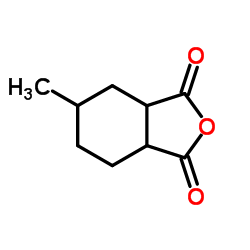Hexahydro-4-methylphthalic anhydride

Hexahydro-4-methylphthalic anhydride structure
|
Common Name | Hexahydro-4-methylphthalic anhydride | ||
|---|---|---|---|---|
| CAS Number | 19438-60-9 | Molecular Weight | 168.190 | |
| Density | 1.2±0.1 g/cm3 | Boiling Point | 300.0±11.0 °C at 760 mmHg | |
| Molecular Formula | C9H12O3 | Melting Point | -29°C | |
| MSDS | Chinese USA | Flash Point | 140.0±16.5 °C | |
| Symbol |


GHS05, GHS08 |
Signal Word | Danger | |
|
Delayed and immediate allergy caused by methylhexahydrophthalic anhydride.
Contact Dermatitis 36(1) , 34-8, (1997) Epoxy resin compounds (ERC) include a large number of chemicals, such as epoxy resins (ER), reactive diluents and hardeners. Many hardeners, e.g., aliphatic polyamines, are well-known sensitizers. Another type of ER hardeners are the phthalic anhydrides, such... |
|
|
Determination of hexahydrophthalic acid and methylhexahydrophthalic acid in plasma after derivatisation with pentafluorobenzyl bromide using gas chromatography and mass spectrometric detection.
J. Chromatogr. B. Biomed. Sci. Appl. 691(2) , 331-9, (1997) A method for the simultaneous determination of hexahydrophthalic acid (HHP acid) and methylhexahydrophthalic acid (MHHP acid) in human plasma was developed. The procedure was a rapid, single step extractive derivatisation with pentafluorobenzyl bromide as the... |
|
|
Human hemoglobin adducts following exposure to hexahydrophthalic anhydride and methylhexahydrophthalic anhydride.
Toxicol. Appl. Pharmacol. 153(2) , 152-60, (1998) Hexahydrophthalic anhydride (HHPA) and methylhexahydrophthalic anhydride (MHHPA) are highly allergenic compounds used in the chemical industry. The aim of this study was to characterize the protein adducts in erythrocytes following exposure to HHPA and MHHPA.... |
|
|
Mass spectrometric characterization of human hemoglobin adducts formed in vitro by hexahydrophthalic anhydride.
Chem. Res. Toxicol. 15(4) , 562-9, (2002) Primary structural information of anhydride binding to endogenous proteins is of interest in order to determine the mechanism causing the type-I allergy seen in many anhydride-exposed workers. In addition, studies on specific protein adducts may generate new ... |
|
|
Biological monitoring of methylhexahydrophthalic anhydride by determination of methylhexahydrophthalic acid in urine and plasma from exposed workers.
Int. Arch. Occup. Environ. Health 70(2) , 128-32, (1997) To investigate whether methylhexahydrophthalic acid (MHHP acid) in urine and plasma can be used as a biomarker for exposure to methylhexahydrophthalic anhydride (MHHPA).MHHPA in air was sampled by Amberlite XAD-2 and analysed by gas chromatography (GC) with f... |
|
|
Immunologic contact urticaria due to airborne methylhexahydrophthalic and methyltetrahydrophthalic anhydrides.
Contact Dermatitis 32(4) , 204-9, (1995) Acid anhydrides are low-molecular-weight chemicals known to cause respiratory irritancy and allergy. Skin allergy has on rare occasions been reported. 2 workers contracted hives and itching on uncovered skin after 2 months exposure to methyltetrahydrophthalic... |
|
|
Determination of 4-methyl-cis-hexahydrophthalic anhydride in human blood by gas chromatography with electron-capture detection.
Analyst 116(12) , 1333-6, (1991) A gas-chromatographic technique using 63Ni electron-capture detection was applied to the determination of 4-methyl-cis-hexahydrophthalic anhydride in the blood of workers occupationally exposed to this airborne agent. The detection limit was 0.24 nmol ml-1. F... |
|
|
Methylhexahydrophthalic anhydride adducted albumin tryptic peptides in nasal lavage fluid.
Inhal. Toxicol. 21(12) , 1013-20, (2009) Methylhexahydrophthalic anhydride (MHHPA) is a reactive, low molecular weight chemical used in products such as plastics, paints, and electronic components. Exposure to MHHPA may lead to work-related airway diseases such as rhinitis, conjunctivitis, and asthm... |
|
|
Biochemical effects and monitoring of exposure of rats to 4-methylcyclohexyl-1,6-dicarboxylic acid anhydride vapour.
Acta Pharmacol. Toxicol. (Copenh.) 59(3) , 209-13, (1986) Male Wistar rats exposed to 5, 10 or 20 p.p.m. 4-methylcyclohexyl-1,6-dicarboxylic acid anhydride vapour for 2-11 weeks showed dose-dependent blood anhydride concentrations. The maximum concentrations were found after two weeks. At five exposure weeks, they w... |